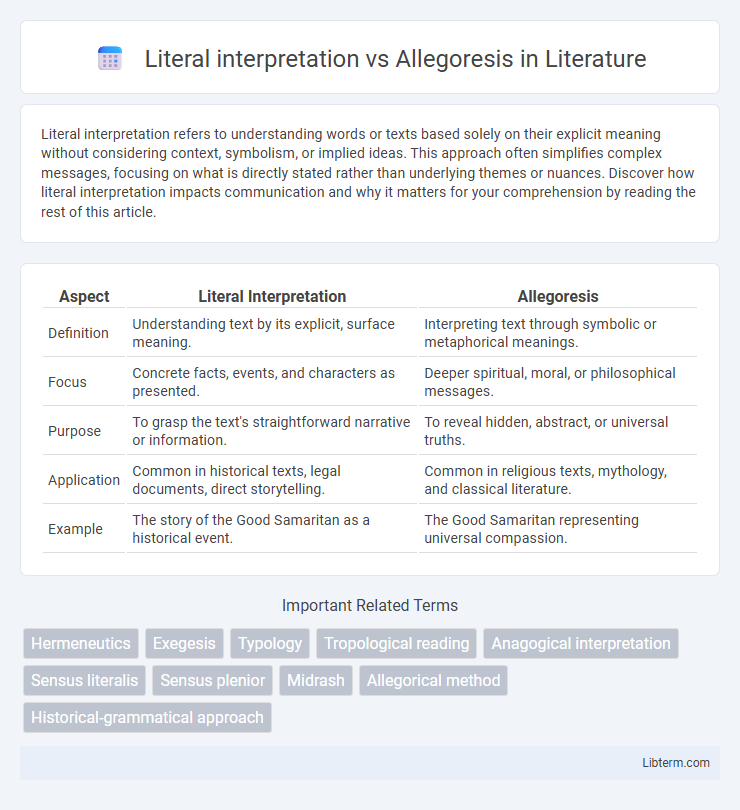Literal interpretation refers to understanding words or texts based solely on their explicit meaning without considering context, symbolism, or implied ideas. This approach often simplifies complex messages, focusing on what is directly stated rather than underlying themes or nuances. Discover how literal interpretation impacts communication and why it matters for your comprehension by reading the rest of this article.
Table of Comparison
| Aspect | Literal Interpretation | Allegoresis |
|---|---|---|
| Definition | Understanding text by its explicit, surface meaning. | Interpreting text through symbolic or metaphorical meanings. |
| Focus | Concrete facts, events, and characters as presented. | Deeper spiritual, moral, or philosophical messages. |
| Purpose | To grasp the text's straightforward narrative or information. | To reveal hidden, abstract, or universal truths. |
| Application | Common in historical texts, legal documents, direct storytelling. | Common in religious texts, mythology, and classical literature. |
| Example | The story of the Good Samaritan as a historical event. | The Good Samaritan representing universal compassion. |
Defining Literal Interpretation
Literal interpretation involves understanding a text by analyzing its explicit, surface-level meaning, emphasizing the exact words and context without inferring deeper symbolic or hidden messages. This approach relies on grammatical, historical, and cultural factors to uncover the author's intended message, often used in legal, biblical, and literary studies. The goal is to provide a clear, unambiguous comprehension based strictly on the text itself, distinguishing it from allegoresis, which searches for metaphorical or spiritual significance beyond the literal words.
Understanding Allegoresis
Allegoresis interprets texts by uncovering symbolic or spiritual meanings beyond the literal words, often revealing deeper theological or moral insights. This method contrasts with literal interpretation, which confines understanding to the explicit, surface-level content. Mastery of allegoresis enhances comprehension of ancient scriptures and classical literature by connecting metaphorical elements to broader cultural and philosophical contexts.
Historical Development of Both Methods
Literal interpretation traces back to early biblical exegesis, emphasizing the direct, surface meaning of texts as rooted in historical context and original language. Allegoresis developed prominently in Hellenistic Judaism and early Christianity, using symbolic or metaphorical readings to reveal deeper spiritual or moral truths beyond the literal sense. Over centuries, these methods evolved with literalism gaining prominence in modern scholarship, while allegoresis influenced theological and mystical traditions.
Key Differences Between Literalism and Allegoresis
Literal interpretation emphasizes understanding texts by their explicit, surface meaning, focusing on the exact words and historical context. Allegoresis, by contrast, seeks deeper, symbolic, or metaphorical meanings beyond the literal text, often uncovering spiritual or moral lessons. Key differences include literalism's reliance on textual clarity and factual accuracy, while allegoresis embraces interpretative flexibility and abstract insights.
Major Proponents and Influential Figures
Literal interpretation, championed by figures such as Thomas Aquinas and John Calvin, emphasizes the straightforward, historical, and grammatical meaning of biblical texts. Allegoresis, advanced by scholars like Philo of Alexandria and Origen, promotes a symbolic or spiritual reading that seeks deeper moral or theological truths beyond the surface narrative. These contrasting hermeneutical approaches have significantly shaped theological discourse, influencing scriptural exegesis and doctrinal development throughout Christian history.
Applications in Religious Texts
Literal interpretation in religious texts emphasizes understanding scripture based on the exact wording and historical context, ensuring clarity and doctrinal consistency. Allegoresis applies symbolic or metaphorical meanings to passages, enabling deeper theological insights and addressing moral or spiritual lessons beyond the surface narrative. Both methods are applied extensively in biblical exegesis, where literal reading grounds legal and historical directives, while allegorical interpretation enriches spiritual teachings and prophetic visions.
Impact on Literary Analysis
Literal interpretation focuses on the explicit meaning of the text, providing clarity and a concrete basis for understanding narrative elements, plot, and character motivations. Allegoresis, by contrast, seeks symbolic or hidden meanings, enriching literary analysis through thematic depth and multi-layered insights that connect text to broader cultural, philosophical, or moral contexts. The impact on literary analysis lies in balancing these approaches to unlock both the surface-level story and its deeper implications, enhancing critical appreciation and interpretative richness.
Criticisms of Literal Interpretation
Literal interpretation often faces criticism for ignoring deeper symbolic or metaphorical meanings embedded in texts, which can lead to a shallow understanding of complex narratives. Critics argue that strict literalism reduces rich, multi-layered religious or literary works to simplistic readings, missing the broader cultural, historical, or ethical contexts. This method may also fail to account for the text's intended audience or original purpose, resulting in misinterpretations and limiting the text's applicability across diverse contexts.
Challenges of Allegorical Reading
Allegorical reading often faces the challenge of subjective interpretation, as meanings can vary widely depending on the reader's perspective and cultural context. This approach risks disconnecting the text from its original historical and literary intentions, leading to potential misrepresentation of the author's message. Moreover, balancing symbolic insights with textual fidelity requires deep theological or philosophical knowledge, complicating consistent application across diverse texts.
Finding Balance: Integrative Interpretive Approaches
Finding balance between literal interpretation and allegoresis involves blending concrete text analysis with symbolic understanding to enhance textual comprehension. Integrative interpretive approaches employ contextual clues, historical background, and literary devices to reconcile the literal meaning with deeper allegorical messages. This synthesis fosters a multidimensional understanding that respects both the explicit content and its potential metaphorical significance.
Literal interpretation Infographic

 libterm.com
libterm.com